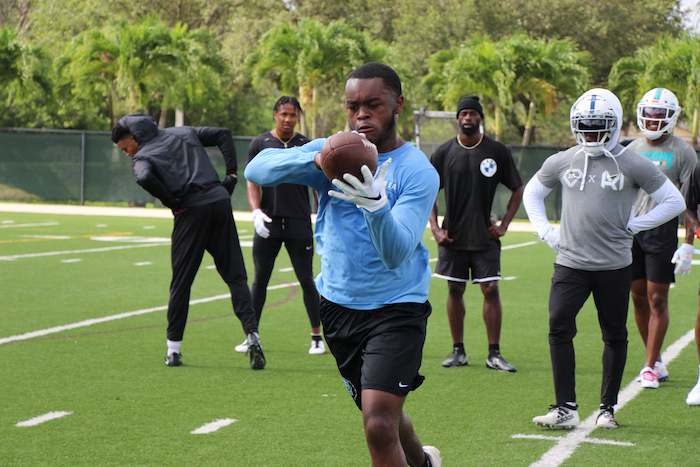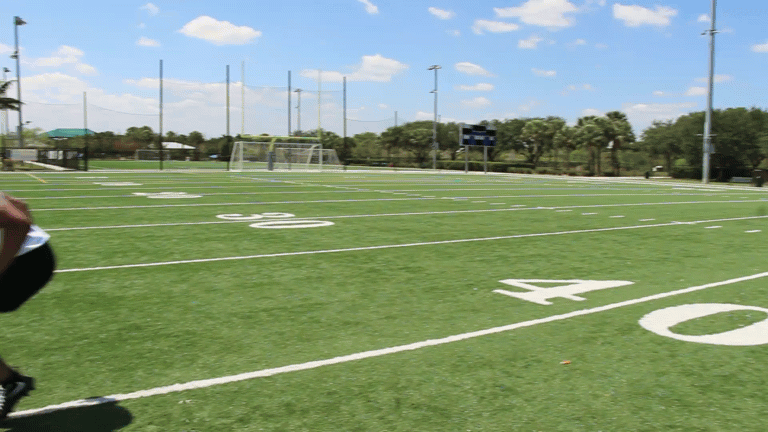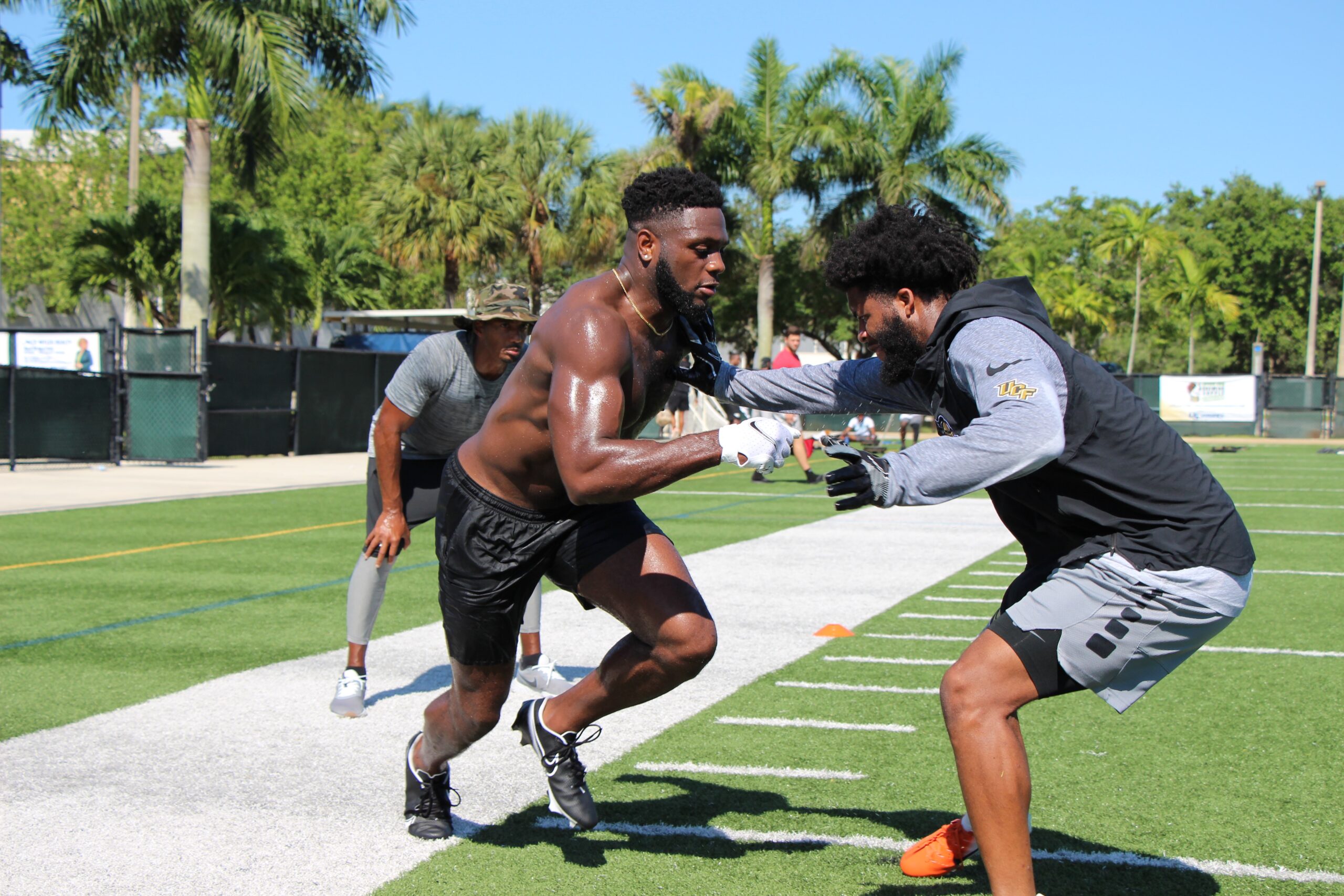
Chad Wilson
October 15, 2025
As defensive back coaches, we all know the mantra: “Fundamentals, fundamentals, fundamentals.” But how do you actually build a practice that effectively teaches, refines, and then tests those fundamentals in a game-like environment? It’s not just about running drills; it’s about running them in a progressive sequence that builds confidence, technique, and finally, competitive instinct.
A well-structured DB practice moves from isolated movements to complex, reactive scenarios. Here’s how to build a dynamic practice, from individual drills to the crucial 1-on-1 competition.
Phase 1: Individual Drills – The Foundation (15-20 minutes)
This is where you isolate and perfect specific techniques without the distraction of a receiver or a ball. Repetition is key here, but it must be quality repetition. Focus on one or two key techniques per segment.
Goal: Master the mechanics of each movement.
Key Drills & Focus:
- Stance & Start:
- Focus: Weight distribution, knee bend, foot placement (toe-instep), eye level.
- Drills: Quick mirror steps (vertical & horizontal), sudden bursts from a dead stop. Emphasize explosiveness, not speed.
- Backpedal & Weave:
- Focus: Low pad level, short choppy steps, weight over the toes, maintaining cushion.
- Drills: Linear backpedal, lateral weaves (matching a coach’s movement), backpedal to 45-degree breaks, backpedal to 90-degree breaks. Emphasize quick feet and fluid hip transitions.
- Hip Flip / Speed Turn:
- Focus: Efficient hip rotation, staying flat, driving off the plant foot, maintaining speed out of the turn.
- Drills: W-Drill, Box Drill, open-turn drills from various angles. Emphasize getting your eyes back to the ball quickly.
- Catching & Attack the Ball:
- Focus: Tracking the ball, high-point technique, hand placement, strong hands.
- Drills: Simple jug machine catches, over-the-shoulder catches with a coach, tracking drills (coach throws the ball from various angles).
Coaching Point: Provide constant, concise feedback. Isolate errors and correct them immediately. This is the “grooving” phase.
Phase 2: Group Drills – Adding Reactivity (15-20 minutes)
Now, we introduce a simulated receiver or a more complex movement pattern. The goal here is to make the DB reactive to a stimulus (e.g., a coach’s release, a pre-determined route) while still refining technique.
Goal: Apply individual techniques reactively; introduce route recognition.
Key Drills & Focus:
- Mirror Drills with a Live Body:
- Focus: Maintaining leverage and cushion against a non-resisting receiver.
- Drills: Coach/player simulates a release (no ball thrown), DB mirrors. Start slow, then increase tempo.
- Route Recognition from Alignment:
- Focus: Understanding how WR splits, stems, and body language indicate routes.
- Drills: Set up various WR alignments (tight, wide, slot). Coach runs a pre-determined route. DB identifies and pedals/reacts correctly without full contact.
- Trail Technique Drills:
- Focus: Playing “out of phase,” using proper hand placement to defend the catch.
- Drills: Coach runs a go route, DB practices staying in phase and then trailing, learning to “rake” or “play the pocket.”
- Pass Breakup Drills (without full contact):
- Focus: Timing, eye contact with the ball, high-pointing, avoiding interference.
- Drills: Coach throws deep balls, DBs practice breaking up the pass against a non-resisting receiver.
Coaching Point: Emphasize reading the receiver and QB. Introduce simple concept keys (e.g., “fast route” vs. “slow route”).
Phase 3: 1-on-1 Competition – The Game Test (10-15 minutes)
This is the ultimate crucible. Players are put in direct competition against a receiver, with a quarterback throwing the ball. This is where technique meets competition, and true playmakers emerge.
Goal: Integrate all learned techniques in a competitive, game-like scenario; develop confidence and competitive edge.
Key Drills & Focus:
- Press 1-on-1:
- Focus: Physicality at the line, rerouting, staying in phase, playing the ball.
- Setup: DB in press, WR runs any route. QB throws.
- Off-Man 1-on-1:
- Focus: Cushion management, backpedal breaks, burst, playing the ball.
- Setup: DB 5-7 yards off, WR runs any route. QB throws.
- Red Zone 1-on-1:
- Focus: Smaller field, condensed routes, tight windows, high-point and contested catches.
- Setup: DB/WR in red zone (e.g., 10-yard line in).
Coaching Point: Create a competitive environment, but reinforce technique first. Reward good footwork and eye discipline, not just the pass breakup. Film these sessions for later review.
Bringing It All Together: Practice Flow Example
Here’s a snapshot of how this progression might look in a 60-minute segment:
- Warm-up/Dynamic Stretch: 10 mins
- Phase 1: Individual Drills: 15 mins (e.g., Stance & Start, Backpedal/Weave)
- Phase 2: Group Drills: 15 mins (e.g., Mirror Drills, Route Recognition)
- Phase 3: 1-on-1 Competition: 15 mins (e.g., Press 1-on-1, Off-Man 1-on-1)
- Cool-down/Review: 5 mins
Conclusion
A successful defensive back practice is a carefully constructed journey. It starts with meticulous individual skill work, layers on reactive scenarios, and culminates in intense 1-on-1 competition. By following this progression, you not only teach your DBs the techniques they need, but you also build their confidence and competitive drive, turning them into consistent playmakers on the field.
Want to dive deeper into specific drills and coaching cues for each phase? Join the All Eyes DB Camp Member’s Area for a complete vault of training resources, film breakdowns, and practice plans designed for elite defensive backs.
Chad Wilson is the owner of All Eyes DB Camp and author of "101 DB Tips". He played college football at the University of Miami and briefly in the NFL for the Seattle Seahawks. Over his 15 year high school football coaching career, he tutored over a dozen Division I defensive backs and as a trainer has worked with NFL All Pros, first round draft picks, college football All Americans and Top 10 ranked high school football prospects.










